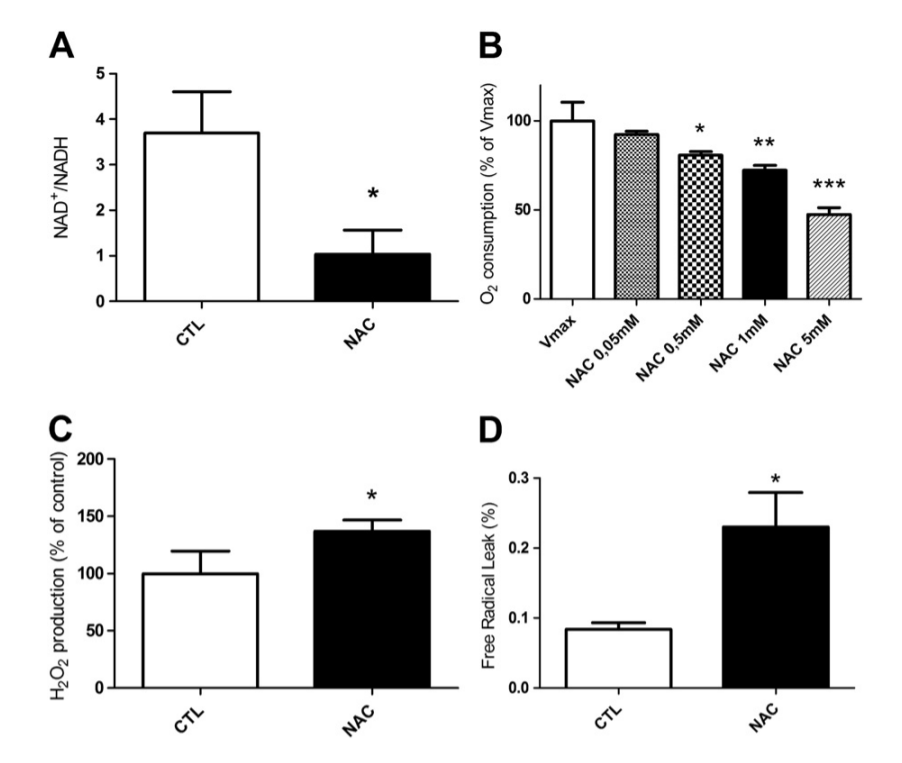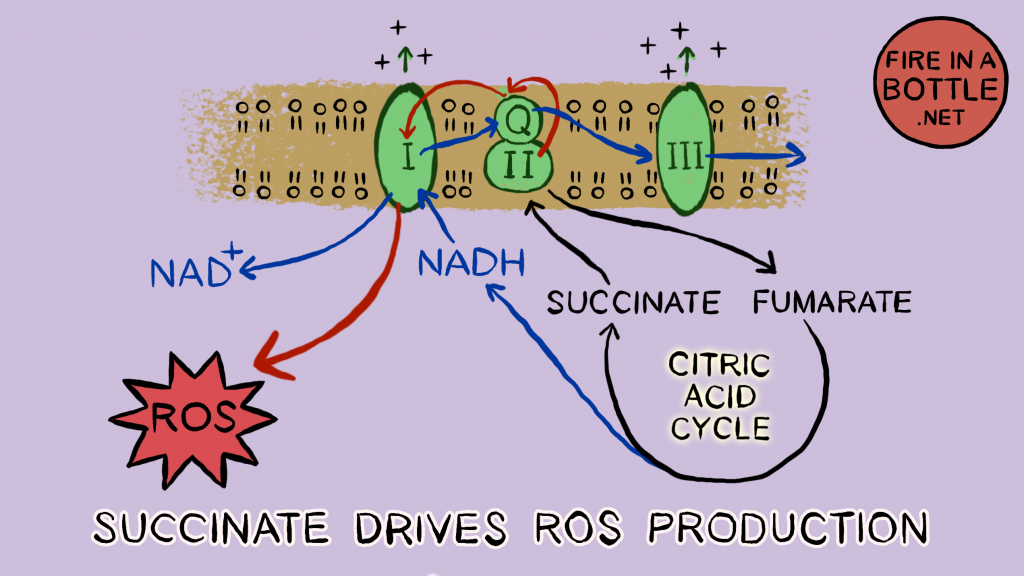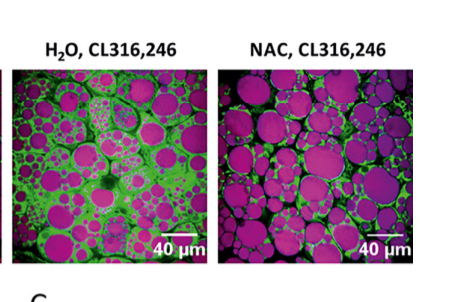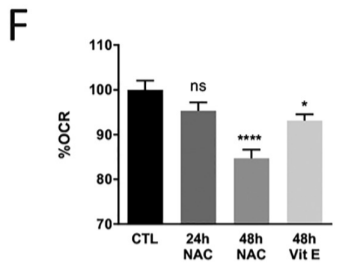Oxidants are electron takers. Anti-oxidants are the opposite: electron donors. OILRIG: Oxidation Is Losing, Reduction Is Gaining.
Oxidative stress can be defined as having too high of a percentage of intracellular “redox couples” in the oxidized state. Glutathione, for instance, is the body’s “master antioxidant”. It can live as either the reduced version (GSH) or the oxidized version (GSSG). When the percentage of GSSG is too high we say the cell has oxidative stress.
Reductive stress is the opposite of oxidative stress and is often characterized by the redox couple NAD+/NADH. The NAD+ is the oxidized form and is lacking an electron (Oxidation Is Losing and hence the positive charge). The NADH form has gained an electron and is the reduced form (Reduction Is Gaining).
If a problem in obesity is reductive stress as defined by a low NAD+/NADH ratio, we can rephrase that as “there are too many electrons”. Much of popular thinking around obesity has been that we could help it with antioxidants, which are electron donors. This is akin to saying, “The baby is drowning, add more bathwater.”
The Antioxidant NAC Acutely Lowers NAD+/NADH Ratio and Metabolic Rate
I’ve argued that a crucial mitochondrial pathway that regenerates NAD+, allowing for an efficient metabolism, is Glutathione-NNT. Glutathione converts Hydrogen Peroxide (ROS) back to water, becoming oxidized in the process. Glutathione reductase uses a molecule of NADPH to reduce the glutathione, creating a molecule of NADP+, which is used to regenerate NAD+ by the enzyme NNT.

If an exogenous antioxidant is applied, this pathway is short circuited and metabolism slows. The more antioxidant you add, the slower will be the metabolic rate.1

In addition to the acute depressive effect on NAD+ level and metabolic rate, the NAC also increases ROS production. The exact mechanism of the increase in ROS is unclear, but a couple possibilities are a) increased Nox4 (the mitochondrial NADPH oxidase) activity due to high levels of NADPH, b) reduced levels of glutathione reductase due to high levels of its end product glutathione or c) reduced NNT activity due to low levels of NAD+ and acetylation by inactivation of SIRT3. Whatever the mechanism is, reductive stress causes elevated levels of ROS.
Readers of the blog might be thinking, “I thought ROS was a good thing.” And it is when it is being efficiently removed by the glutathione-NNT pathway. Cellular levels of ROS are determined by their rate of production minus their rate of removal. Reductive stress creates a removal problem.
This is, in fact, why I recommend supplementing with lipoic acid in addition to Succinade. The lipoic acid is to convert some NADH to NAD+ to get things deacetylated and electron flow moving. The Succinade is to generate some more ROS to help balance out your mostly unsaturated body fat which is probably what gave you the reductive stress in the first place. I’ve been taking lipoic acid first thing in the morning then following with Succinade two hours later.

Antioxidants Prevent Adrenal Driven Thermogensis
In the second paper2, mice were given an adrenal hormone mimic (CL316,246) for ten days. One group was given normal water and the other was given NAC in their drinking water for three days before and the ten days during adrenal stimulation. The mice given water only had massively increased mitochondrial content and lowered fat content in their white adipose tissue compared to the mice given NAC.

Again the antioxidant leads to a buildup of ROS. In tissue culture there is increased lactate export – a marker of reductive stress – at the same time as increased markers of oxidative stress. Antioxidants cause reductive stress which causes oxidative stress.
This pro-oxidant effect of antioxidants was, even in the absence of 3-AR stimulation (adrenal mimic), associated with decreased oxygen consumption and increased lactate production in adipocytes. We observed similar antioxidant effects in WT mice: NAC blunted 3-AR stimulation–induced browning of white adipose tissue and reduced mitochondrial activity in brown adipose tissue even in the absence of 3-AR stimulation. NAC … increased mitochondrial oxidative stress. … chronic antioxidant supplementation can produce a paradoxical increase in oxidative stress associated with mitochondrial dysfunction in adipocytes.
Peris & Asterholm, “Antioxidant treatment induces reductive stress associated with mitochondrial dysfunction in adipocytes”
Vitamin E And Soybean Oil
The second paper2 showed a similar effect to NAC on metabolic rate using Vitamin E – an antioxidant.

Did you know that the single most potent dietary source of gamma-tocopherol – a form of vitamin E – is soybean oil? If you wanted to give yourself reductive stress, consuming a food which contains a lot of PUFA to minimize ROS generation combined with a potent antioxidant to reduce glutathione reductase and/or SIRT3 activity would presumably be an excellent way to get there.
- 1.Singh F, Charles AL, Schlagowski AI, et al. Reductive stress impairs myoblasts mitochondrial function and triggers mitochondrial hormesis. Biochimica et Biophysica Acta (BBA) – Molecular Cell Research. Published online July 2015:1574-1585. doi:10.1016/j.bbamcr.2015.03.006
- 2.Peris E, Micallef P, Paul A, et al. Antioxidant treatment induces reductive stress associated with mitochondrial dysfunction in adipocytes. Journal of Biological Chemistry. Published online February 2019:2340-2352. doi:10.1074/jbc.ra118.004253

Interesting note about the soybean oil there. I often claimed it’s one of the unhealthiest oils for a litany of other reasons, this just adds to it. Interesting that almost everything in the US that is packaged or cooked out (especially fried foods) uses tons of the stuff.
Might have to stop taking NAC that the wife and I have been taking since getting Covid in Feb 2020.
If I were going to take any antioxdiant, it would be NAC, since at least that can be made into glutathione, but still it might be best just to get sufficient glycine and let your figure out the rest. Gelatin for the win. I have so many aspics planned for the Christmas season…
I have stopped but my wife will continue since it really helps her breath normally. Aspics are fantastic! Plan on making some Pate to give out as gifts this Christmas. That way they open the gift and always share…heh.
Astaxanthin is an antioxidant as well correct?
It is said to be, but it’s unclear how it works. Antioxidant is a very overused word. This paper suggests that astaxanthin works as a pro-oxidant.
Interestingly, a carnivore diet is sufficient in every required nutrient EXCEPT vitamins C and E. Articles online will tell you to add fruit to make sure you get enough vitamin C, and add nuts & seeds for the vitamin E.
Fruits are nature’s most significant source of vitamin C. Nuts & seeds are nature’s most significant (only?) major source of vitamin E. Both are seasonal, and would be consumed by animals around the time inducing torpor would be necessary. It’s probably not a coincidence that these vitamins are a) unavailable in the “springtime diet” and b) concentrated in the “late summer/fall diet”. Nature doesn’t make mistakes.
This is probably one of the main issues with Paleo eating too – sure, natural sugars, fruit, and nuts are totally “appropriate” human foods… depending on what you want to signal your body to do at any given time.
Ruminants, as well as many other animals, make their own Vitamin C. Beef and pork both have Vitamin C and E. Liver is a good source of Vitamin C, E, A, D…
Pretty sure there’s not NEARLY as much vitamin C or E in liver as there are in fruits or nuts, respectively. That was my point…
I think the point of my post was mostly missed.
The relatively small amounts of C and E naturally found in our biologically appropriate foods are good for us.
The larger amounts of C and E that would impact metabolism seem to (naturally) come with (seasonal) fruits and nuts – I’d assume by design.
Eating liver? Good. Taking supplements that would equal 14 oranges at a time? Probably not metabolically advantageous.
Real foods have biological consequence – the consequence of taking in large amounts of C and E might be assisting torpor.
It’s not surprising that C & E are abundant in seeds and nuts, considering that one of their best-known functions is protecting PUFA from peroxidation. Doesn’t explain why citrus and leafy greens have a load of C though.
Well said….pleased you restated your point…it’s crossed my mind recently but I didn’t think it thru like you did.
So I understand it may not be a good strategy to supplement high doses of NAC or Vit E, but what about vitamin C or selenium? During cold and flu season, especially in this age of Covid, it’s common for people to supplement with some of those to stay well. Thoughts? Is it possible that doses like 500mgs or Vit C might be ok but not super high doses?
Vitamin C appears mostly beneficial to the healing process for collagen synthesis. Why not just supplement collagen? Healing soups are an ancient remedy for a reason. 🙂
The collagen you eat gets broken down by digestion, so it still needs vitamin C for reassembly.
Taking Vitamin C to bowel tolerance will resolve many infections and is dose dependent based on the severity of the infection. I don’t think this is anything to do with collagen. Your body needs those electrons to fight.
Yeah, you really can’t go wrong with collagen. Aspic for the win. Also, many of the Firebrand Meats boxes will have skin on ham hocks now. THAT’s some collagen for you!
IDK, I’ve never personally supplemented with Vit C. I guess I would say to be aware that you’re pushing your metabolism in a certain direction. Some will get away with this better than others.
I was heavily supplementing with vitamin C and E when I first started my current weight loss protocol. I was under the (mistaken) impression that I needed it because “releasing all the stored PUFA was very toxic” and I wanted to be safe.
The thing is, I really only started losing weight consistently once I ditched the C and E, based largely on my interpretation of your previous posts and ideas about antioxidants and ROS.
*Shrug*
Just curious – what weight loss protocol are you following?
At the time of my post, I was doing pure lean protein just to satiety (which, honestly, ended up basically being fasting!)
When I did eat, I chose mostly skinless chicken breast, white fish, or extra lean cold cuts that I could grab out of the fridge easily. It wasn’t what I wanted to be doing for various reasons, but it was the ONLY way I could lose weight at first.
However, I’ve since been able to move into a saturated “fat fasting” type regimen similar to the Bulletproof Rapid Fat Loss Protocol (or Carb Nite Solution) and I have been having VERY good results with this! I am much happier using high fat instead of high protein during my weight loss. I modified my plan and use Pu-Er Tea (instead of coffee) and stick to pure Cocoa Butter Wafers instead of butter & MCT Oil because cocoa butter is a fat format that I find very pleasant to eat while still having all that stearic acid we’re after. MCT oil stalls me out – I think it’s probably benign in our diet but not necessarily helpful the way long chain saturates appear to be. N=1 though.
As per the Bulletproof protocol (or the Carb Nite Solution, if you prefer) I have an eating day every Monday that strictly adheres to Brad’s principles. I haven’t been doing this long enough to really comment on it but so far so good.
Long term, my approach is going to be to fast (or fat fast) “down to the bone” to get rid of the PUFA faster than we can otherwise slowly displace it. I’m not going to suggest it’s best for everyone, but I have iron willpower for adhering to fasting plans, I’m super experienced in fasting, and very comfortable. I like the cocoa wafers better than water fasting when I’m going for 6 days a week.
I’m not worried about metabolism at all. My body temperature is slowly but steadily rising and I’m seeing some of my hypothyroid symptoms (like temperature drop after meals) reverse thanks to Brad’s information. Not sure how this will change as I get closer to a low BMI but for now it’s encouraging. I start to burn up and hit 99.0+ body temp after eating TCD style meals despite fasting 6 days a week.
That vitamin C and E stuff is Ray Peat bs. He’s right about PUFA being bad, but I disagree with him about everything else. Some stuff he preaches is just plain not true. I guess even a broken clock is right twice a day.
Very interesting anecdote. This is what I would predict, it’s interesting (although obviously not conclusive) to see your real life experience.
Interesting, most interesting. Particularly the part where reductive stress hampers your ability to deal with the upcoming ROS afterwards.
So “eating healthy” as modern folks would put it is 100% opposite of what you should be doing. The folks swilling some alcohol, eating steak, maybe binging on french fries and having some candy afterwards…… might have a point
What about supplementing with a NAD+ booster such as Nicotinamide Riboside (NR) to improve the NAD+/NADH ratio? I’m quickly realizing it’s hard to determine just how such things impact the mitochondrial process given this example with NAD and ROS production.
I was taking some NR in the morning fasted but stopped as there wasn’t consensus over at /r/saturatedfat/ on whether not that was helping or hindering what we are trying to do on TCD. I liked the energy it gave me and would like to add it back in but I don’t want to stymy my efforts vis-a-vis the stearic/sterculia/succinate/berberine/ALA I’m taking.
Like I said, I have no problem with it per se.
Another good way to improve NAD/NADH ratio is to lower CD38 expressing cells (which consumes NAD). I see very little talk of that in most health circles.
Yup. Upcoming post on this….
Hey Brad, something a bit off-topic but I want to share a personal story with you. I came across your work quite some time ago now and have achieved excellent weight stability at a very low bodyfat level by incorporating a very high percentage of saturated fat. This by itself is great since i always had weight problems. But the really interesting (and a bit concerning) part is that in last years summer after a period of deliberately eating very much ghee with stearic acid added to it i noticed 3 moles on my skin getting inflamed and then simply falling off after a while. Since then i‘m wondering if i dodged a few cancerous bullets there? Can‘t be sure but i still wanted to thank you.
Thanks for the feedback! My guess is the moles are unrelated, but it is impossible to say.
Just received and consumed your succinade very tasty (: I have a genetic polymorphism that keeps coming up says I have very low glutathione production and even stranger I react to NAC thats when I found your product, I currently also take quicksilver liposomal glutathione but it sounds like this may not be a good idea?
also was going to ask how often can I or should I be drinking the succinade
In mice it worked well for weight loss at ~2% of calories. That’d be 40 calories in the context of a 2000 calorie diet, which would be about 2 scoops of the succinade.
It’s hard saying if you have low production levels. I’ve been reading this which suggests that overweight humans have a more glutathione and it is more reduced (less oxidized) than in lean humans, which matches up pretty well with the Ray Peat excerpt that Eric posted.
Hi Brad,
Is supplementing glutathione of benefit? You don’t really talk about it but have mentioned glutathione several times.
Thanks!
Jenn
I’m not a big fan of the concept. For instance, I’ve just been reading this which suggests that glutathione is higher in overweight humans.